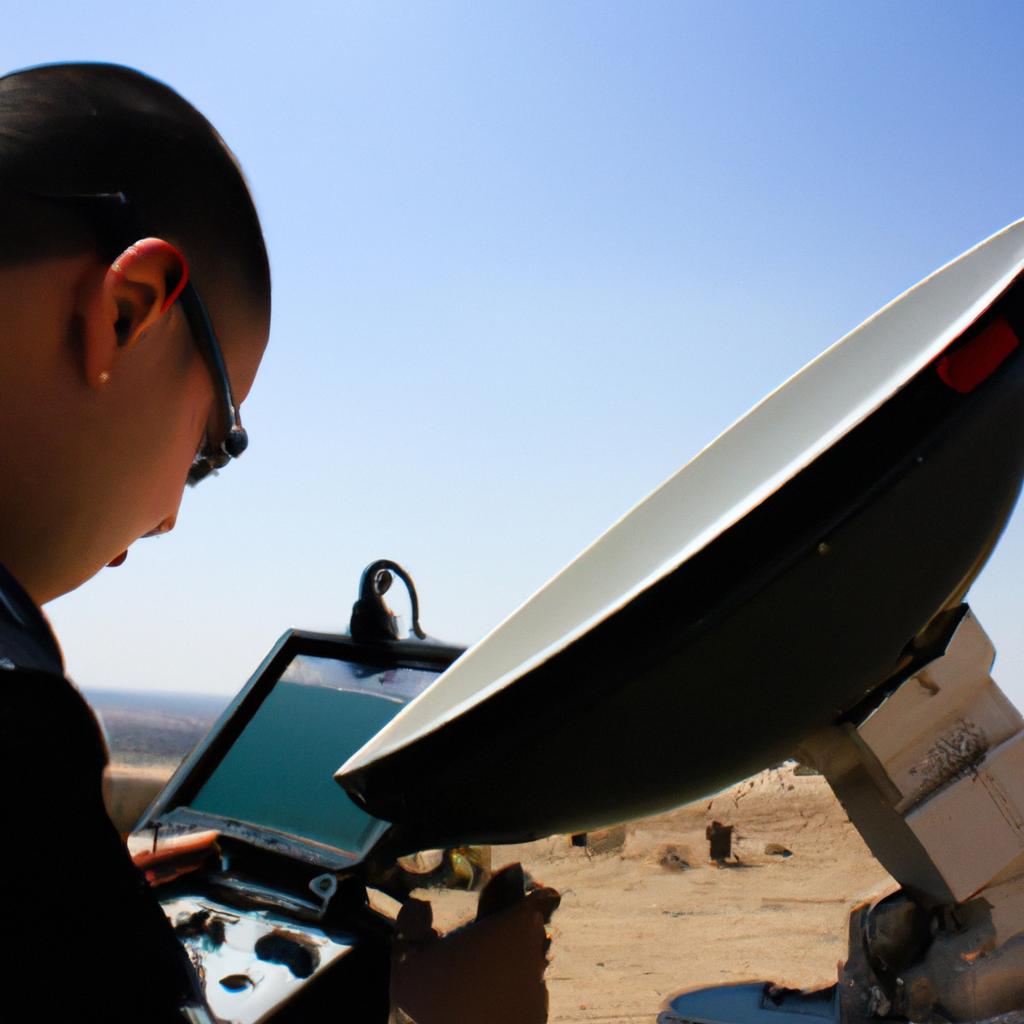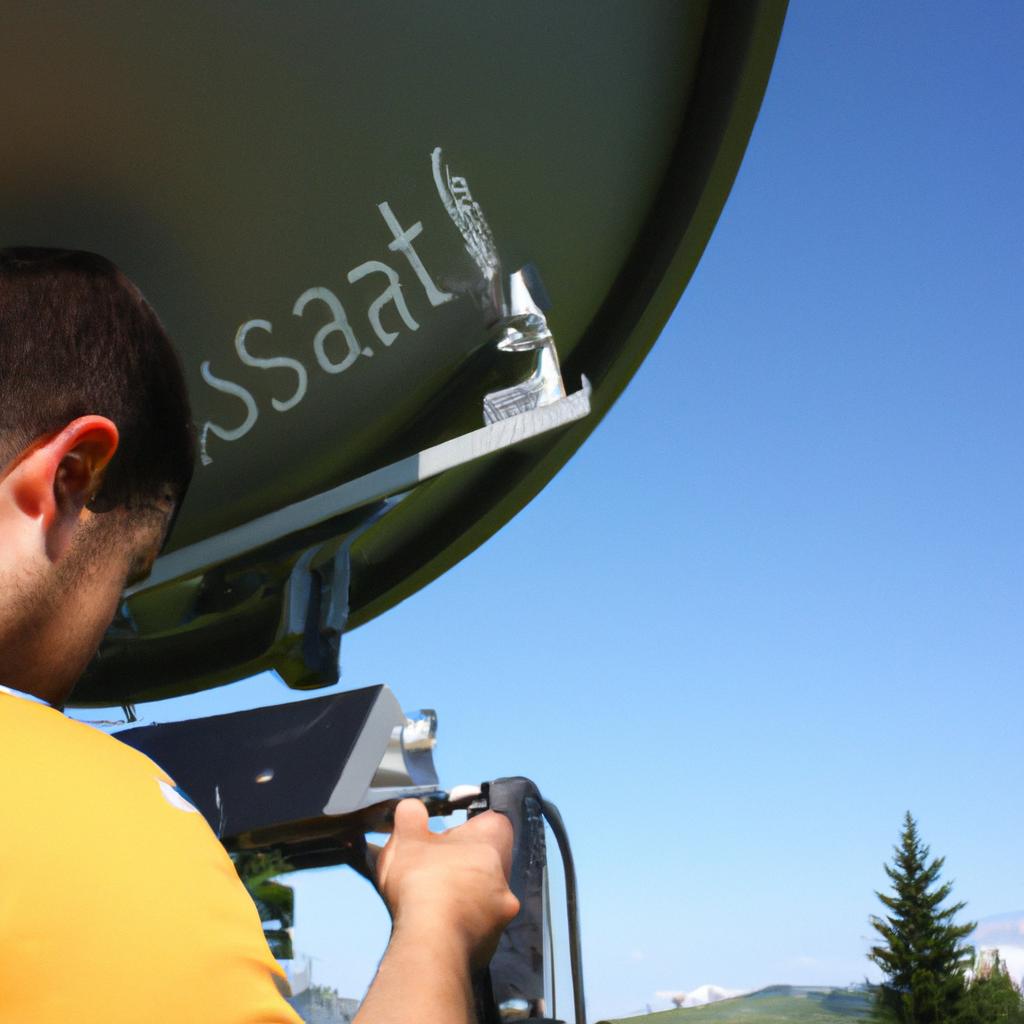Satellite propulsion methods play a crucial role in the operation and maneuverability of aerospace and defense satellites. These advanced technologies enable these satellites to achieve precise orbits, maintain position, perform attitude control, and adjust their trajectories as needed. Understanding the different propulsion methods used in satellite systems is essential for optimizing mission capabilities and ensuring efficient utilization of limited resources.
One notable example that highlights the significance of satellite propulsion is the case study of the Mars Reconnaissance Orbiter (MRO). Launched by NASA in 2005, this spacecraft utilized various propulsion techniques during its journey to Mars and subsequent operations in Martian orbit. By employing a combination of chemical thrusters for initial trajectory corrections and electric propulsion for long-duration maneuvers, MRO successfully reached and entered into a highly elliptical polar orbit around Mars. This achievement would not have been possible without the integration of effective propulsion mechanisms, showcasing the critical importance of satellite propulsion methodologies in space exploration missions.
In this article, we will explore different types of satellite propulsion systems used in aerospace and defense applications. We will delve into both traditional chemical-based methods such as monopropellant and bipropellant engines as well as emerging technologies like ion thrusters. Additionally, we will examine key considerations associated with selecting an appropriate propulsion system for specific missions and discuss future developments in satellite propulsion technology.
When selecting a propulsion system for a specific mission, several factors must be taken into account. These include the spacecraft’s mass and size constraints, desired maneuverability and delta-v requirements, mission duration, power availability, and overall cost considerations. Each propulsion method has its advantages and trade-offs in terms of efficiency, thrust capability, fuel consumption, and operational lifespan.
Traditional chemical-based propulsion systems are commonly used for initial launch maneuvers and major orbital adjustments due to their high thrust capabilities. Monopropellant engines utilize a single propellant such as hydrazine or MMH (monomethylhydrazine) combined with a catalyst bed to produce hot gases for thrust generation. These engines offer simplicity, reliability, and versatility but have limited specific impulse (Isp) values compared to other methods.
Bipropellant engines employ two separate propellants: a fuel and an oxidizer. The most commonly used combination is liquid hydrogen (LH2) as the fuel and liquid oxygen (LOX) as the oxidizer known as cryogenic bipropellants. These engines provide higher Isp values than monopropellant systems but require more complex plumbing arrangements and careful handling of cryogenic fuels.
Electric propulsion systems represent a growing field of interest for long-duration missions that demand precise orbit control while conserving fuel resources. Ion thrusters are one example of electric propulsion technology that uses charged particles (ions) accelerated by electric fields to generate low-thrust output over extended periods. Although ion thrusters have very low thrust levels compared to chemical rockets, they provide significantly higher Isp values, resulting in greater fuel efficiency over time.
Other emerging technologies being explored include solar sails that harness the momentum transfer from photons emitted by the Sun to propel spacecraft forward without conventional propellants. Additionally, nuclear thermal propulsion concepts utilizing nuclear reactions to heat propellants offer potential advancements in terms of efficiency and thrust capabilities.
In conclusion, satellite propulsion systems are essential for achieving precise orbits, maintaining position, performing attitude control, and adjusting trajectories in aerospace and defense applications. Selecting the appropriate propulsion method depends on various factors such as mission requirements, spacecraft constraints, fuel efficiency goals, and cost considerations. As technology advances, new propulsion methods like electric propulsion and innovative concepts like solar sails and nuclear thermal propulsion may revolutionize future space missions by offering enhanced maneuverability, increased fuel efficiency, and extended operational lifespans.
Chemical Propulsion: The use of chemical reactions to generate thrust for satellite propulsion systems.
One example that highlights the significance and effectiveness of chemical propulsion in satellite systems is the case study of the Hubble Space Telescope. Launched into orbit in 1990, the Hubble has revolutionized our understanding of the universe through its remarkable observations and discoveries. Behind this success story lies a sophisticated chemical propulsion system that enabled the telescope to reach its intended orbit and conduct scientific research at unprecedented levels.
In order to comprehend the functioning of chemical propulsion, it is essential to understand its key components and mechanisms. Chemical propulsion relies on the principle of Newton’s third law, which states that every action has an equal and opposite reaction. In this context, thrust is generated by igniting a propellant mixture consisting of fuel and oxidizer within a combustion chamber. As these chemicals react exothermically, high-pressure gases are expelled from the nozzle with tremendous force, generating forward momentum for the satellite.
The advantages offered by chemical propulsion make it appealing for aerospace and defense satellites:
- High Thrust: Chemical rocket engines can provide large amounts of thrust, allowing satellites to accelerate quickly and achieve desired orbits efficiently.
- Flexibility: Different combinations of propellants can be used depending on mission requirements, making chemical rockets adaptable to various scenarios.
- Reliability: Years of development have resulted in highly reliable chemical propulsion systems that have powered numerous successful space missions.
- Maneuverability: Satellites equipped with chemical propulsion systems can perform complex orbital maneuvers such as inclination changes or stationkeeping.
Table 1 showcases some commonly used propellant combinations employed in chemical propulsion systems:
| Fuel | Oxidizer | Example Applications |
|---|---|---|
| Hydrazine | Nitrogen Tetroxide | Attitude control thrusters |
| Liquid hydrogen | Liquid oxygen | Launch vehicles |
| Monomethylhydrazine | Nitrogen Tetroxide | Geostationary satellites |
| Hypergolic fuels (e.g., Aerozine-50) | Nitrogen Tetroxide | Interplanetary missions |
It is evident that chemical propulsion plays a crucial role in the success of satellite missions. However, it is important to note that this method has certain limitations, including its finite propellant supply and the potential for toxic byproducts. These drawbacks have led researchers and engineers to explore alternative methods such as electric propulsion, which will be discussed in the subsequent section.
Electric Propulsion: Utilizing electric power to accelerate ions or plasma for propulsion presents an innovative approach to overcome some of the challenges associated with chemical propulsion systems.
Electric Propulsion: Utilizing electric power to accelerate ions or plasma for propulsion.
Chemical propulsion has long been the dominant method used for satellite propulsion systems. However, with advancements in technology and a growing need for more efficient and cost-effective solutions, electric propulsion has emerged as an alternative method that offers numerous advantages. This section explores electric propulsion and its applications in aerospace and defense satellites.
One fascinating example of electric propulsion is the Deep Space 1 mission by NASA. Launched in 1998, this spacecraft utilized ion thrusters to achieve impressive speeds while requiring significantly less propellant compared to traditional chemical rockets. By accelerating ions or plasma using electric power, these systems can generate thrust over longer periods of time without the need for large amounts of fuel.
Electric propulsion offers several key benefits that make it attractive for satellite missions:
- Greater fuel efficiency: Electric thrusters have a much higher specific impulse (ISP) than chemical rockets, allowing satellites to operate for extended durations while consuming comparatively less propellant.
- Increased payload capacity: Since electric propulsion requires less fuel mass, it allows satellites to carry larger payloads or additional scientific instruments.
- Extended operational lifespan: The lower propellant consumption of electric propulsion enables satellites to extend their useful life by conserving fuel reserves for stationkeeping maneuvers or orbital adjustments.
- Enhanced maneuverability: Electric thrusters provide precise control over thrust levels, enabling finer trajectory adjustments and improved orbit insertion accuracy.
To further illustrate the capabilities of different electric propulsion technologies, consider the following comparison table:
| Propulsion System | Specific Impulse (s) | Thrust Range (mN) | Efficiency |
|---|---|---|---|
| Hall Effect Thruster | 1500 – 3000 | 10 – 100 | High |
| Ion Thruster | 2000 – 3500 | 5 – 50 | Very high |
| Magnetoplasmadynamic Thruster (MPDT) | Up to 5000 | 100 – 200 | Excellent |
These figures demonstrate the diverse range of electric propulsion systems available, each with its own characteristics and applications. The specific impulse indicates the efficiency of converting propellant into thrust, while the thrust range denotes the magnitude achievable by these thrusters.
In summary, electric propulsion has proven to be a promising alternative to chemical methods for satellite propulsion in aerospace and defense applications. Offering greater fuel efficiency, increased payload capacity, extended operational lifespan, and enhanced maneuverability, it presents numerous advantages for various mission requirements. As we explore further advancements in satellite propulsion technologies, let us now delve into another innovative method known as solar sails: using the pressure of sunlight on large reflective sails to generate propulsion.
Solar Sails: Using the pressure of sunlight on large reflective sails to generate propulsion.
Transitioning from the previous section on electric propulsion, another innovative method used in satellite propulsion is solar sails. Solar sails utilize the pressure of sunlight on large reflective sails to generate propulsion. This concept relies on the principle that photons, or particles of light, have momentum and can transfer energy when they collide with a surface. By reflecting these photons off a highly reflective sail, satellites can harness this force for propulsion.
To better understand how solar sails work, let’s consider an example: Imagine a hypothetical scenario where a small spacecraft is equipped with a solar sail and deployed into space. As it moves away from Earth, sunlight starts to exert pressure on the sail due to its reflection. The constant stream of photon collisions gradually accelerates the spacecraft forward without consuming any fuel. Although the acceleration may be relatively slow compared to other methods, over time, solar sails could allow spacecraft to reach high velocities while conserving valuable propellant resources.
Solar sails offer several advantages and considerations:
- Endless Energy Source: Unlike traditional rocket engines that rely on finite fuel reserves, solar sails draw power directly from sunlight.
- Environmental Friendliness: Since solar sails do not emit exhaust gases or consume chemical propellants during operation, they are environmentally friendly alternatives for satellite missions.
- Long-Duration Missions: Solar sails enable long-duration missions by continuously utilizing available sunlight as their source of propulsion.
- Precision Maneuverability: Solar sails provide precise maneuverability as adjustments in orientation can change the amount of sunlight intercepted by the sail.
| Advantages | Considerations |
|---|---|
| Endless Energy Source | Limited effectiveness far from sun |
| Environmental Friendliness | Slow initial acceleration |
| Long-Duration Missions | Susceptible to micrometeoroid damage |
| Precision Maneuverability | Complex deployment mechanisms |
In summary, solar sails present an exciting prospect for aerospace and defense satellites. Their ability to harness sunlight for propulsion offers numerous advantages, including endless energy source and environmental friendliness. However, their effectiveness may be limited in regions far from the sun, and they require careful consideration of factors such as initial acceleration and vulnerability to micrometeoroid damage.
Transitioning into the next section on ion propulsion: Ionizing and accelerating propellant to produce thrust, we delve into another method that revolutionized satellite propulsion with its efficiency and long-duration capabilities.
Ion Propulsion: Ionizing and accelerating propellant to produce thrust.
Building upon the concept of ion propulsion, another method used for satellite propulsion is Nuclear Propulsion. This advanced technology harnesses the power of nuclear reactions to generate thrust, offering a promising solution for aerospace and defense satellites. To further explore this method, let us delve into its principles, potential applications, advantages, and challenges.
Nuclear Propulsion presents an intriguing possibility for satellite propulsion due to its ability to provide significant amounts of continuous thrust over extended periods. One example that highlights the potential benefits of nuclear-powered satellites is the concept of interplanetary missions. By employing nuclear propulsion systems, spacecraft can achieve higher velocities and reduce mission durations when traveling vast distances within our solar system. For instance, a hypothetical Mars mission utilizing nuclear-powered satellites could significantly decrease travel time from Earth to Mars by reducing reliance on conventional chemical rockets.
To better understand the key aspects associated with Nuclear Propulsion in satellite systems, consider the following:
-
Potential Applications:
- Interplanetary exploration
- Deep space missions
- Long-duration orbital maneuvers
-
Advantages:
- High specific impulse (Isp)
- Enhanced maneuverability
- Extended operational lifespan
- Reduced fuel consumption compared to chemical propulsion
-
Challenges:
- Safety concerns regarding radioactive materials
- Regulatory frameworks surrounding nuclear energy usage in space
- Technical complexity and development costs
Incorporating nuclear propulsion into future satellite designs necessitates addressing safety concerns while adhering to stringent regulations governing the use of nuclear energy in space operations. Nonetheless, if these challenges are overcome successfully through rigorous research and development efforts, Nuclear Propulsion holds great promise as an efficient means of achieving ambitious deep-space missions and revolutionizing satellite capabilities.
Moving forward from exploring Nuclear Propulsion’s potential, the subsequent section will delve into another intriguing method known as Magnetic Propulsion: Harnessing electromagnetic forces to generate thrust for satellite propulsion.
Nuclear Propulsion: Utilizing nuclear reactions to generate thrust for satellite propulsion.
Imagine a future where satellites can travel farther and faster than ever before, exploring the depths of our solar system. This could be made possible through the use of nuclear propulsion systems. Nuclear propulsion involves harnessing the power of nuclear reactions to produce thrust for satellite propulsion. Although still largely theoretical, this method holds great promise in revolutionizing space exploration.
One example that showcases the potential of nuclear propulsion is Project Orion, a concept developed by physicist Freeman Dyson in the 1950s. It involved using controlled nuclear explosions behind a spacecraft to propel it forward. While never realized due to safety concerns, Project Orion demonstrated how nuclear energy could significantly increase a spacecraft’s velocity and enable interstellar travel.
To better understand the advantages and challenges associated with nuclear propulsion, consider the following points:
- Enhanced speed: Nuclear propulsion offers much higher specific impulse compared to traditional chemical rockets, allowing satellites to reach higher velocities.
- Extended mission duration: The high energy density provided by nuclear reactors allows satellites to operate for longer durations without refueling.
- Increased payload capacity: With more efficient propellant utilization, satellites utilizing nuclear propulsion can carry larger payloads or additional scientific instruments.
- Interplanetary exploration: Nuclear-powered spacecraft have the potential to explore destinations beyond Earth’s orbit, such as Mars or even outer planets like Jupiter and Saturn.
| Advantages | Challenges |
|---|---|
| Higher speeds | Safety concerns |
| Longer mission durations | Regulatory hurdles |
| Increased payload capacity | Environmental considerations |
| Interplanetary exploration capabilities | Cost and resource requirements |
In summary, while currently limited by technical and regulatory challenges, nuclear propulsion has immense potential in advancing space exploration efforts. As scientists continue to refine its concepts and address safety concerns, we may witness an era where interstellar missions become within our grasp.
Transitioning into the subsequent section about “Magnetic Propulsion: Using magnetic fields to propel satellites,” the exploration of alternative propulsion methods presents yet another exciting avenue for satellite development.
Magnetic Propulsion: Using magnetic fields to propel satellites.
Section H2: Magnetic Propulsion: Using magnetic fields to propel satellites.
Transitioning from the previous section on nuclear propulsion, another innovative method for satellite propulsion is magnetic propulsion. This approach involves harnessing magnetic fields to generate thrust and maneuver spacecraft in outer space. While still in the experimental stage, magnetic propulsion shows promise for its potential application in aerospace and defense satellites.
One example of magnetic propulsion is the concept of electromagnetic tethering. In this scenario, a long conducting wire is deployed from the satellite into space while maintaining an electric current flow through it. The Earth’s magnetic field interacts with the current running through the tether, creating a Lorentz force that propels or deorbits the satellite depending on the direction of the current. This technique has been proposed as a means to adjust orbits without using large amounts of fuel.
To better understand the advantages and challenges associated with magnetic propulsion, consider the following:
- Advantages:
- Reduced reliance on chemical propellants.
- Potential for extended operational lifetimes due to decreased fuel consumption.
- Enhanced orbital control and maneuverability.
- Lower costs over time by minimizing refueling needs.
Despite these benefits, there are several key factors that must be considered when implementing magnetic propulsion systems:
| Factors | Impact | Challenges |
|---|---|---|
| Power | High | Efficient power generation required |
| Safety | Medium | Avoidance of electrical hazards |
| System Complexity | High | Precise integration and calibration needed |
| Environmental Effects | Low | Limited impact compared to other methods |
In conclusion, magnetic propulsion offers exciting possibilities for future satellite missions within aerospace and defense industries. By utilizing electromagnetic forces, such technology can potentially reduce dependency on traditional chemical rockets while providing greater flexibility in orbit adjustments. Despite remaining challenges regarding power efficiency, safety considerations, system complexity, and environmental effects – magnetic propulsion has the potential to revolutionize satellite propulsion methods in the near future.
 Louth Online
Louth Online



